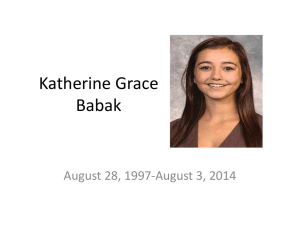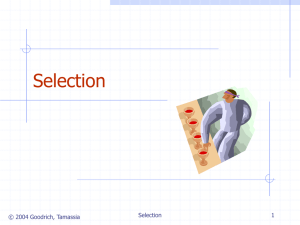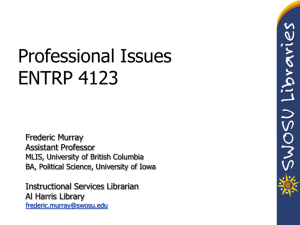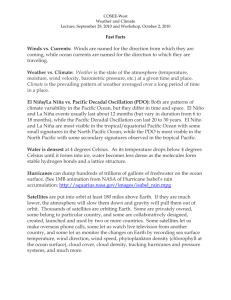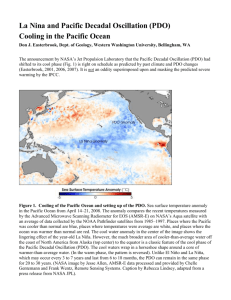West o East Studying Weather from 6
advertisement
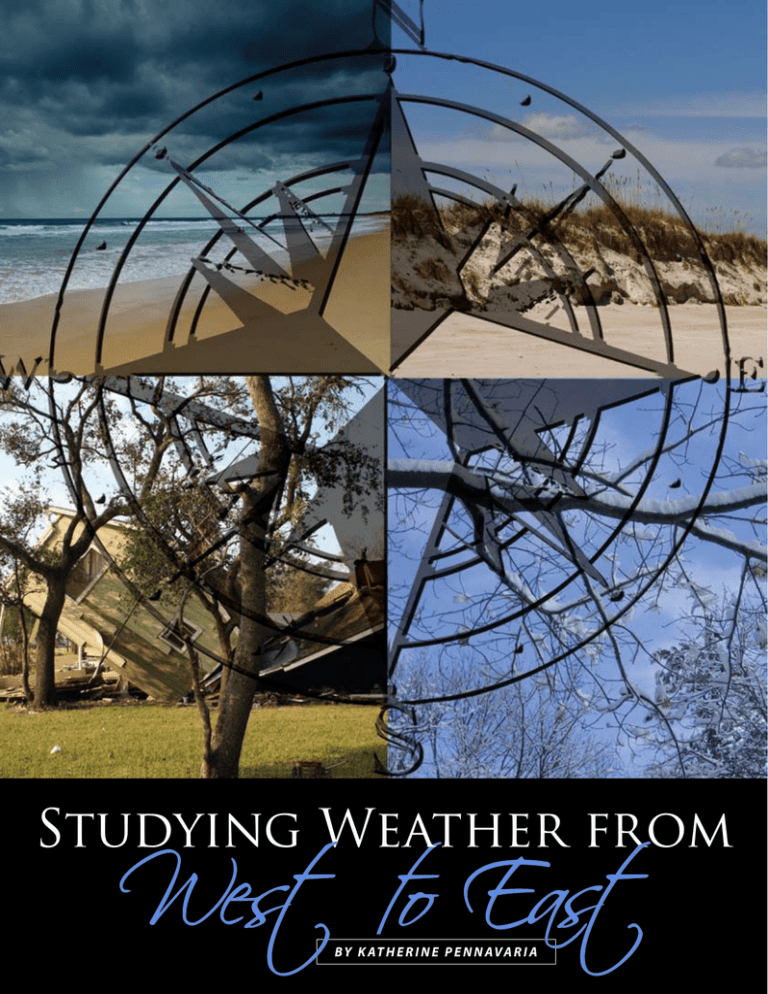
West o East Studying Weather from 6 WKU Scholar | Spring 2009 B y K at h e r i n e P e n n ava r i a Theories about the Pacific Decadal Oscillation (PDO), have developed in the last decade. The PDO is a northern Pacific phenomenon occurring roughly every thirty to fifty years. Both El Niño and the PDO have warm, cold, and neutral phases to each cycle. Anyone watching the weather news in the past few months might have noticed something: the weather Dr. Greg Goodrich systems all move from west to east. Ever wonder why? Dr. Greg Goodrich of the Western Kentucky University Department of Geography and Geology has the answer. Goodrich, who joined the WKU faculty in 2005 after completing his Ph.D. from Arizona State University, studies the long-term temperature changes in the oceans and how those changes affect the world’s atmosphere. Since weather moves from west to east and because he lives in the United States, Goodrich has concentrated his research primarily on the Pacific. “The weather we have now, two days ago was in the Rocky Mountains,” he says. “The Atlantic is where our weather goes.” Goodrich has published his research in numerous peer-reviewed journals, including Climate Research, the Bulletin of the American Meteorology Society, and Weather and Forecasting. The most famous weather phenomenon is El Niño, which refers to annual disturbances caused by temperature fluctuations in the surface of the tropical eastern Pacific Ocean. The name, which means “the little boy,” was given because the phenomenon is usually noticed around Christmastime off the western coast of South America. El Niño is associated with floods and droughts all over the world. But the tropical region isn’t alone in creating the world’s weather. According to Goodrich, the El Niño phenomenon has been understood for about half a century, but theories about another cycle, the Pacific Decadal Oscillation (PDO), have developed in the last decade. The PDO is a northern Pacific phenomenon occurring roughly every thirty to fifty years. Both El Niño and the PDO have warm, cold, and neutral phases to each cycle. It’s the combination of the phases between the two cycles that fascinates Goodrich. “If they’re both in the same phase, the effect on climate is enhanced; if they’re out of phase, the effect on climate is weakened,” he explains. Some scientists do not accept that the PDO exists, because climate modelers have yet to figure out how and why it works. “The only way you can see it is in a map of sea surface temperatures,” says Goodrich. Understanding and predicting the PDO has practical applications. “The wine producers in the west really care about this,” Goodrich notes. For the last few decades, wine growers have had “perfect wine-growing weather” because the El Niño and PDO cycles have not combined to create spring frosts and summer rain, weather that would ruin the grape crop. But a few years ago, Goodrich and a colleague predicted that the PDO would shift from warm to cold, making spring frosts more likely. Some researchers disagreed, saying the temperatures would remain high because of global warming. However, Goodrich notes, “April of 2008 brought the worst frost in thirty years to Napa Valley, which caused great damage to the grapes.” Now the wine-growers pay more attention to the PDO. Another West coast group interested in Goodrich’s research is the National Forest Service (NFS). The same cycles that can create a terrible season for grapes can create prime fire conditions. “A wet winter causes growth of vegetation,” he says, “and if the following summer is hot and dry, there is more fuel for fires.” The NFS has asked Goodrich to help them create a forecasting tool so they can plan ahead for demanding fire seasons. The research is in its early stages, he says. “My goal is to develop a fire forecasting model.” WKU Scholar | Spring 2009 7 Goodrich likes to involve students in studying weather phenomena that particularly affect Kentucky. Under his guidance, a group of seven graduate and undergraduate students developed a list of the worst snowstorms to hit Kentucky since 1960. They used the relationship between the El Niño and PDO cycles to explain why some years bring no major snowstorms and other years bring several. 2009 appears to be one of the latter so far. Goodrich became interested in weather and climate when he lived in Arizona and witnessed how the cycles affected the local environment. “The population growth out there is unsustainable relative to the water supply,” he says, “and we’re heading into a cycle of possible decadal drought. They’re not prepared for that.” He thinks we might see some serious “water wars” in the West over who gets what share of the Colorado River. Right now the states share the water according to an agreement that is almost one hundred years old. But, Goodrich points out, “they divided the river water according to the population at that time and how the river was flowing at that time.” According to his research, the agreement was drawn up during one of the wettest cycles in the past thousand years. Now the area is in a period of drought, and the river cannot keep up with demand. To illustrate the difference between the climate of the Ohio Valley and that of the southwest, Goodrich notes that the former receives about fifty inches of rain a year, and the latter about seven inches. “In Nevada, they pay people to take out grass lawns and put in rock yards,” but other steps are more difficult. He thinks that in order for the population of the southwest to continue at its present growth rate, they’ll have to commit to large-scale use of recycled (“gray”) water, especially for car washes and golf courses. “There are no more reservoirs to tap,” he says, “and no more wells to drill.” Recently, Goodrich has begun looking at the Atlantic Ocean cycles as well. The circulations of the Atlantic are not directly connected to those of the Pacific, so the cycles don’t affect each other, but the Atlantic cycles do affect Florida and Texas, both of which have rapidly growing populations. He sees his future research moving more toward the eastern United States, and focusing on how weather cycles affect agriculture. Notes Goodrich, “It’s harder, though, because the farther you get from the Pacific, the more subtle these signals become.” According to Mark Twain, everyone always talks about the weather, but no one does anything about it. Perhaps someday, if Goodrich and his colleagues succeed in compiling enough data about meteorological cycles, we might be able to. n To illustrate the difference between the climate of the Ohio Valley and that of the southwest, Goodrich notes that the former receives about fifty inches of rain a year, and the latter about seven inches. In Nevada, they pay people to take out grass lawns and put in rock yards. 8 WKU Scholar | Spring 2009
